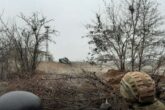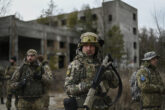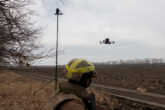December 07, 2020
Air Force Structure in the Next National Defense Strategy
The Bottom Line
- The next National Defense Strategy should identify and describe a joint theory of victory vis-à-vis China and Russia.
- This theory of victory should be the starting point for budget deliberations, instead of beginning by allocating shares of the budget to each service.
- The size and shape of the Air Force and the allocation of resources among all the services should be driven by this theory of victory.
- At present, the Air Force is both too small to meet current combatant command (COCOM) requirements and too large to remain ready and modernized under its current budget.
Introduction
Like all the U.S. military services, the Air Force faces force structure decisions that will shape and define both its future and the options it presents to future national security decisionmakers.
But of all the services, the Air Force may face the most challenging decisions. This is because the service is not big enough to fulfill all the demands on its capabilities in current operations, yet is too big for its existing share of the defense budget.
The Air Force is of insufficient size to both fulfill all the national security requirements in current operations and maintain the readiness necessary to deter or defeat peer adversaries. Continuing deployments to combat violent extremist organizations and deter Iran have reduced the time available for unit training and have limited or reversed hard-fought readiness gains. Outdated training systems and infrastructure limit training against new threats posed by China and Russia. Regaining the training time required to improve readiness will require some combination of reduced deployment tempo and increased force structure—which means an increased share of the budget.
Of all the services, the Air Force may face the most challenging decisions.
However, the service is already too big and busy for its existing budgets. Maintaining the current number of platforms, systems, and people costs more every year due to supporting aging systems and recruiting and retaining a volunteer force. Because the Air Force has not been allocated enough money to maintain the number of units required to meet current demands, ensure the readiness for countering peer adversaries, and transform force structure to meet the new threats, the service is at a breaking point.
Addressing the future threats posed by China and Russia will require transformation of all the elements of U.S. power to meet these multifaceted challenges. China and Russia have pursued approaches that focus on breaking the alliances between the United States and regional partners, while holding U.S. forces at a distance long enough to defeat forward-based troops. Should either China or Russia rapidly defeat forward-based forces, the United States would be compelled to carry out sustained offensive operations over long distances, to reverse the opponent’s conquests, in the face of continuous logistics challenges.
The service is at a breaking point.
To address these issues, the Department of Defense (DoD) is focused on fielding a new generation of long-range fires that will counter Chinese and Russian innovations. All the U.S. military services have proposed their own versions of these systems and processes. No matter how accurate and lethal the new systems become, they will need persistent air- and space-based intelligence, surveillance, and reconnaissance (ISR) to reliably find, fix, and target mobile adversary systems. In turn, these ISR systems will require persistent air- and space-based protection, thus driving the need for a transformation of Air and Space Force platforms, systems, and concepts.
Key Air Force Questions Must Be Addressed
Within this planning environment—which is constrained by the challenge of balancing current operations, readiness requirements, and modernization, as well as by organizational barriers to change—the Air Force must make a series of key decisions. Each must be thought through, resourced within available funds, and defended through the budgeting processes.
Deterrence in the 21st century.
What are the right tools to deter 21st-century threats? Assuming that nuclear weapons still discourage the use of increasingly available and modernized threats against the United States, what is the right mix of land-, air-, and sea-based systems? Delays in modernization have driven the need to upgrade or replace all the elements of U.S. nuclear capability. The Air Force is responsible for modernizing three of the four major components of the nuclear triad: responsive ground-based ballistic missiles; air-launched weapons that provide flexible deterrence for the United States and NATO; and the command-and-control system that make these systems safe and reliable. But time has proven that nuclear weapons are not sufficient to deter all threats. Russia, China, and other nations have employed cyber and informational tools below the threshold of nuclear response. How should the United States deter future cyber, biological, and other threats to the homeland and U.S. allies? What investments are required? All of these questions must be considered and answered.
Networks vs. command and control (C2).
The services have reached a general consensus that future warfare will necessitate advanced networks and C2 capabilities, now referred to as Joint All Domain Command and Control (JADC2). But each service has its own ideas about how this system should work, and each is concerned that a new joint system will leave out its already existing systems, forcing costly upgrades. Air Force efforts have focused on the networks and software that will connect future warfighters. It must decide how to divide the C2 requirements on this network between artificial intelligence (AI)–driven algorithms and human contributions, and how to build the appropriate C2 structures and processes. The Air Force, like all the services, must complete a digital transformation to take advantage of JADC2 capabilities.
Intelligence, surveillance, and reconnaissance.
It is essential to determine the right mix of air, space, cyber, and publicly available information sensors needed to gather the ISR data that will support national security decisionmakers and warfighters against China and Russia. The appropriate balance—which needs to be determined—between human analysts and AI will produce a system that makes sense of all this information in a timely way.
Inside vs. outside.
The Air Force must retain the ability to operate inside the range of China’s and Russia’s proliferated long-range fires, because U.S. air, land, and sea forces must all operate and base inside their own effective ranges. The best balance of systems, platforms, and weapons required to operate inside and outside these ranges must be established.
Long-range standoff vs. short-range persistence.
The services are competing to develop and employ new families of standoff weapons. Air-launched weapons offer advantages in their response time, basing, and flexibility. Hypersonic weapons can reduce the time needed to track mobile adversary systems and defeat terminal air defenses. Long-range systems depend on sensors that can maintain track of targets from launch through intercept. Shorter-range manned and unmanned systems provide more persistence over targets but rely on defendable and sustainable basing. How the Air Force should prioritize investments in long-range sensors, platforms, and weapons must be carefully considered.
Manned and unmanned platforms.
China and Russia have invested in multiple systems designed to break communication links between C2 centers and platforms. Warfighting against them will require autonomous systems able to make decisions and fight without constant communications. In this regard, how much of that autonomy can be delegated to unmanned systems is another key question. Some determinations will still require an autonomous person at the point of decision.
Control of the air.
The Joint Force must protect the necessary penetrating air systems and operating bases from air and surface threats. For this, the Air Force may need to build a new penetrating air control platform. To protect forward bases, the Air Force may have to invest in surface-to-air defenses.
Sustainment vs. combat power.
Forward bases must be sustained under attack. How the Air Force will accomplish that must be determined, along with the investments required. New airlift or tanker platforms and concepts may have to be developed.
Cyber and information warfare.
The joint force must have additional cyber and information resources to compete with Russia and China. The Air Force may need to expand its information and cyber forces. It could acquire organic offensive or defensive cyber capabilities, or, alternatively, it could continue to present them through combatant commands (COCOMs).
Modernization roadmaps.
The Air Force should present a time-phased plan for replacing aging mobility, bomber, and fighter platforms. ISR and cyber forces must also be updated routinely. The balance must be found between modernizing existing systems and acquiring new ones.
Training and development.
An Air Force transformed by answering these questions will require a transformed operational training infrastructure. The airmen who will operate and lead this future Air Force must be prepared through a mix of appropriate education, training, and experiences, in both live and computer-generated environments. Getting education and training right will be just as important as determining future force structure.
Organizing for peer competition.
Current Air Force organizations and formations are designed for efficient home station training operations and predictable deployments to prepared bases. These structures and processes must be adjusted to fit a focus on peer conflict. Headquarters organization should be shaped and consolidated to facilitate effective transformation planning and execution. Similarly, new processes must be established at wing levels and below to conduct agile expeditionary operations from austere bases.
Barriers to Air Force Transformation
In making the key determinations described here, the Air Force faces institutional roadblocks both inside the Pentagon and on Capitol Hill.
DoD budget processes.
The military budgets are built in a zero-sum process based on each service’s share of previous years’ allocations. The Department of Defense provides fiscal guidance during planning that divides the resources between the services and non-service accounts (the “fourth estate”), based on previous decisions. Beginning the planning process by allocating shares instead of starting with resourcing a theory of victory against prioritized threats makes shifting budget shares a very difficult process. The Air Force budget is further complicated by the “pass-through” and stand-up of the Space Force. Money apportioned to the Air Force account but actually spent in other places (primarily the intelligence community) is generally counted as part of the Air Force’s share. Funding for the new Space Force was also taken off the top of the Air Force budget. Service competitions over concepts and doctrine (the right theory of victory) and tools (the right platforms and systems) often mask competitions over resources that are reflected in discussions of roles and missions.
Congressional budget processes.
Reenforcing the idea that all politics are local, the DoD budget is spent locally in states and districts, and states and communities fight to preserve or expand their share of the funding. This regional ownership of bases and corporate manufacturing facilities makes it hard to negotiate retirement of aging or less-relevant systems unless a dollar-for-dollar and job-for-job replacement can be negotiated with communities and industry.
Recommendations
- The DoD should update the National Defense Strategy to identify a shared theory of victory for competition with China and Russia. This theory of victory should be the starting point for budget deliberations. How will the United States compete with, deter, and, if necessary, defeat the objectives of China and Russia? What force elements are required? Which service should provide them? The Department should also provide force management guidance to balance short-term deployment availability with the training time needed to build forces with the long-term readiness and retention needed to execute the theory of victory.
- The DoD should coordinate executable multi-year force structure modernization roadmaps with Congress to address community concerns and needs. Without a roadmap, each community views force structure retirement proposals as existential threats to its survival.
- The DoD should prioritize force elements to support a review and update of service roles and missions. Critical questions needing answers should include:
- How should the DoD prioritize and coordinate the development of new long-range fires and the ISR and C2 systems required to use them effectively?
- How much nuclear modernization is necessary as part of 21st-century deterrence? How will the United States pay for it? Should the nuclear mission sets be more evenly distributed across the services?
- What offensive and defensive counterair force elements are needed? Which services should provide the air- and surface-based systems required?
- What force elements are not necessary to execute the theory of victory and should be traded to pay for the additional force elements that are needed?
Conclusion
The military services face daunting force structure challenges and decisions as the United States shifts focus from decades of war countering violent extremist organizations to competition with China and Russia. The Air Force is too small to meet COCOM requirements, yet too big to balance current ops, readiness, and modernization within its current budget. Air Force choices will affect the alternatives available to national security decisionmakers and warfighters for years to come. Successful resolution of these issues will require updated strategies and approaches to budget planning and execution.
About the Author
General Mike Holmes (Ret.) is a senior advisor at the Roosevelt Group. He retired from the Air Force in 2020 as the Commander of Air Combat Command and previously served as the Air Force’s Deputy Chief of Staff for Strategic Plans and Requirements.
Learn More
From July to December 2020, CNAS will release new papers every week on the tough issues the next NDS should tackle. The goal of this project is to provide intellectual capital to the drafters of the 2022 NDS, focusing specifically on unfinished business from the past several defense strategies and areas where change is necessary but difficult.

The Next Defense Strategy
About this commentary series By statute, the Department of Defense (DoD) must deliver a new National Defense Strategy (NDS) to Congress in 2022. And CNAS is here to help. From...
Read MoreMore from CNAS
-
Defense / Transatlantic Security
When Defense Becomes Destruction: Austria-Hungary’s Mistake and Ukraine’s RiskThis article was originally posted on War on the Rocks. The southeastern Polish city of Przemyśl, with its elegant 19th century Habsburg-era train station, remains one of the ...
By Franz-Stefan Gady
-
Defense / Transatlantic Security
Ukraine’s Catch-22 MomentThis article was originally published in the Financial Times. In Joseph Heller’s wartime classic, Catch-22, the protagonist Yossarian seeks out the US army surgeon Doc Daneeka...
By Franz-Stefan Gady
-
CNAS Insights | Budgetary Own Goals Undermine “Speed and Volume”
On November 7, Secretary of Defense Pete Hegseth laid out a plan to overhaul the Department of Defense’s (DOD’s) acquisition system. Placing an emphasis on delivering new capa...
By Philip Sheers, Carlton Haelig & Stacie Pettyjohn
-
Drones: Who Is Making the New Weapons of War?
From Ukraine and Russia to Gaza and Sudan, drones have become a key weapon of war. Which companies are making them, and profiting from this rapidly expanding but controversial...
By Stacie Pettyjohn




